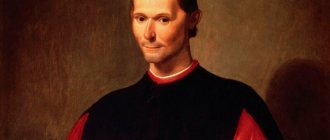Picasso Quotes
Prepared by: Dmitry Sirotkin
I present to you a selection of quotes from the Spanish artist Pablo Picasso (1881-1973).
This man led us to modern painting .
Quotes are grouped by topic: painting, life ethics, artists, about themselves, art, creativity, love, idea, youth, work, success, children, money, peace, understanding, human manifestations, old age. Quotes about Picasso are provided.
About painting
Painting still needs to be invented.
Painting is just another way of journaling.
Painting is stronger than me and always makes me do what it wants.
Painting is an activity for the blind. The artist paints not what he sees, but what he feels.
If we could get rid of our brains and use only our eyes...
Painting is something sacred. It would also be necessary to say that if a painting has great power of influence, this is because it contains the spirit of God. But people may misunderstand this expression. Meanwhile, it is closest to the truth.
An artistic movement only wins when it is adopted by window decorators.
I can't stand people who talk about beautiful things. What is beautiful? We need to talk about problems in painting!
Why do two colors located next to each other sing? Can someone explain this? No. That's why no one will ever be able to teach you how to draw.
Should we draw what's on the face, or what's inside or behind it?
Colors, like facial features, follow changes in emotions.
About life ethics
I'm not looking. I find it.
Maybe the one who thinks he can. But the one who thinks he can’t can’t. This is an immutable, undeniable law.
There's nothing worse than a great start.
I always do what I don't know how to do. Otherwise how can I learn?
If you want to keep the shine on a butterfly's wings, don't touch them.
I don't believe in coincidences. In history there are only unexpected collisions.
Sow seven times, cut once.
There are no irreplaceable ones, but there are unique ones.
If there was only one truth, you would not be able to paint a hundred canvases on the same topic.
About the artists
An artist is a receptacle of emotions that come from everywhere: from heaven, from earth, from the rustling of paper, from fleeting forms, from cobwebs.
Good artists copy, great artists steal. (authorship unknown)
An artist is a person who paints something that can be sold. And a good artist is a person who sells what he writes.
Everyone has the right to change, even artists.
Only a few people understand a beginning artist. Famous - even less.
Some artists depict the sun as a yellow spot, while others turn the yellow spot into the sun.
When art critics get together, they talk about form, structure and meaning. When artists get together, they talk about where they can buy cheap solvent.
About Me
My mother told me: “If you become a soldier, you will be a general, if you become a monk, you will be an abbot.” Instead, I became an artist - and became Picasso.
I want to convey everything that I have experienced in my life to people through my brush.
Some see what is there and ask why. I see what could be and ask “why not?”
I depict objects the way I think about them, and not the way I see them.
Give me a museum and I'll fill it.
Real artists are Rembrandt, Giotto, and I'm just a clown; The future in art belongs to those who know how to make faces.
If all the roads that I have walked were marked on the map and connected into one line, it would look like a minotaur.
About art
Art is a lie that makes us aware of the truth.
Art is the elimination of the unnecessary.
Art washes away the dust of everyday life from the soul.
Art is the child of orphanhood and melancholy. Others write their lives, I paint pictures.
No one has ever seen a natural work of art.
Hidden harmony is better than obvious.
Who sees the human face correctly: the photographer, the mirror or the artist?
If you want to sell an unnecessary item, call it a work of art.
People who make art their business are mostly scammers.
Sculpture is an art of the mind.
By the way, quotes about art
About creativity
To draw, you must close your eyes and sing.
Every act of creation is initially an act of destruction.
Create in a painting as in life - directly.
Good taste is the worst enemy of creativity.
Everything you can imagine is real.
When inspiration comes to me, it finds me at work.
By the way, quotes about creativity
About love
If there was no one to love, I would fall in love with a doorknob.
Love is the best restorer.
When we fall in love with a woman, we don't mentally measure the length of her legs.
There are only two types of women - goddesses and litter.
By the way, quotes about love
About the idea
I start with an idea and then it becomes something else.
An idea is a starting point and nothing more. Once you master it, it transforms into a thought.
You should have an idea of what you are going to do, but it should not be entirely specific.
About youth
Youth has no age.
You have to spend a lot of time to finally become young.
40 is the age when you finally feel young. But it's too late.
About work
Work is a necessity for a person. Man invented the alarm clock.
Without great solitude, serious work is impossible.
I rest when I work and get tired when I am idle or receiving guests.
By the way, quotes about work
About success
Put off until tomorrow only what you do not want to complete until the day you die. Action is the main key to success.
Success is fraught with danger. You begin to copy yourself, and this is even more dangerous than copying others. This leads to infertility.
By the way, quotes about success
About children
Every child is an artist. The difficulty is to remain an artist beyond childhood.
I can draw like Raphael, but it will take me a lifetime to learn to draw like a child.
By the way, quotes about children
About money
I want to live like a poor person with money.
I don’t own any of my paintings because a Picasso original costs several thousand dollars—a luxury I can’t afford.
By the way, quotes about money
About the world
The world around us today does not create sensations, is that why I should paint pictures?
The world today makes no sense. So why should I paint pictures that have meaning?
By the way, quotes about peace
About understanding
Is there anything more dangerous than sympathetic understanding?
Everyone is trying to understand painting. Why don't they try to understand birdsong?
About human manifestations
And among people there are more copies than originals.
It is more difficult to make yourself hate than to love yourself.
About old age
We don't grow old, we mature.
With age, the wind gets stronger. And he's always in your face.
About miscellaneous
We Spaniards are mass in the morning, bullfighting in the afternoon and brothel late in the evening.
God is an artist just like other artists. he created the elephant, the giraffe and the cat. He has no real style, but he sticks to new ideas.
Einstein's genius led to Hiroshima.
Computers are useless. They can only give answers.
As we can see, Picasso views most phenomena and problems through the prism of painting . Sometimes such optics give rather unexpected results .
Quotes about Picasso
- J. Cocteau: When he sets off on a journey, he never knows where he will end up, but his path always ends in triumph.
- L. Poldes: An anti-harmonious, psychotic composer of typewriters and rattles, Erik Satie, for the sake of his pleasure, smeared the reputation of the Russian Ballet with mud, causing a scandal, at a time when talented musicians humbly wait to be played... And the geometric mongrel and dirty guy Picasso got out to the front of the stage while talented artists humbly wait to be showcased.
- K. Chanel: There was something vicious about him. He was as charming as a hawk and scared me a little. I felt when he entered the room; Something in me froze. He is here! I hadn’t seen him yet, but I already felt his presence. Only then did she find him with her eyes. He looked at me like that... It made me tremble. (by the way, quotes from Chanel)
- S. Dali: The biological and dynastic phenomenon that makes up Picasso's Cubism was the first great imaginative cannibalism that surpassed the experimental ambitions of modern mathematical physics. (by the way, quotes from Dali)
- G. Stein: We must not forget that the reality of the twentieth century was different from the reality of the nineteenth century. Picasso was the only artist who felt this, indeed the only one... Matisse and the others looked at the twentieth century, but saw what happened in the nineteenth.
- V. Konetsky: If Newton could say that he achieved a lot only because he stood on the shoulders of giants, then this could not be said by Picasso, who spent huge amounts of money at auctions of monkey paintings. Apparently Picasso found something as important in chimpanzee painting as in The Sistine Madonna. To some extent, Picasso stood on the shoulders of a chimpanzee.
Then you can move on to other collections:
- Van Gogh quotes
- Leonardo da Vinci quotes
- Hemingway quotes
- Mayakovsky quotes
- Saint-Exupery quotes
- Einstein quotes
I would be grateful if you share the link to the article on social networks with your friends. Use the network buttons below .
Comments are also highly welcome!
I. group errors
Synthesis * Ventriloquism * Folk wisdom
1. “Good artists copy, great artists steal.”
2. “Behind every great fortune lies a crime.”
3. “No one can make you feel inferior without your consent.”
4. “The moral arc of the universe is long, but it bends toward justice.”
5. “For the triumph of evil, only the inaction of good people is enough.”
6. “Genius is 1% inspiration and 99% perspiration.”
7. “The question is not who will let me, but who will stop me.”
8. “Don’t cave in. Don't cut corners. Don't try to subordinate everything in life to logic. Don’t betray yourself in pursuit of fashion.”
9. “In the struggle for survival, the fittest win at the expense of the competition.”
10. “Life is a journey, not a destination.”
11. “640 kilobytes [of computer memory] should be enough for anyone.”
12. “Be kind to everyone. Everyone you meet is fighting their own uphill battle.”
13. “The purpose of life is to discover your gift. The meaning of life is to give this gift.”
14. “We do not inherit the Earth from our ancestors; we borrow it from our children.”
15. “If you love someone, give them freedom. If a person returns, he is yours.”
16. “Give a man a fish and he will eat for a day. Teach a man to fish and you feed him for life.”
17. “Choose something you love, and you will never have to work a day in your life.”
18. “The bird doesn’t sing because it has an answer, it sings because it has a song.”
Synthesis
1. “Good artists copy, great artists steal” (Pablo Picasso)
In 1988, in the Sydney Morning Herald
an article was published about lawsuits in the computer industry and the development of
Macintosh
, in which the author quotes a controversial statement by Steve Jobs, an iconic entrepreneur, one of the founders of
Apple
: ["Computers Keep the Courts Active," Sydney Morning Herald, April 11, 1988, 20 , https://goo.gl/zxSf74.]
...
“Good artists copy, great artists steal,” Steve Jobs said he kept this phrase from Pablo Picasso in mind when he was developing computers.
Jobs then repeated it in an interview for the TV series Triumph of the Nerds: The Rise of Accidental Empires
) produced by PBS (this conversation later formed the basis of the full-length documentary film “
The Lost
): [["The Television Program Transcripts: Part III,” companion website for 1996 PBS television program Triumph of the Nerds, accessed March 6 , 2013, https://www.pbs.org/nerds/part3.html.]r> ...
It all comes down to trying to discover the best that people have created and then bringing it into your own creativity. You know, as Picasso said: “Good artists copy, great artists steal” - and my colleagues and I always shamelessly stole great ideas. I think Macintosh
became an excellent product partly because musicians, poets, artists, zoologists, historians, who also turned out to be the best computer scientists in the world, worked on its creation.
In 1996, when the program was published, the statement was repeated by a film critic for the Philadelphia Inquirer
, accidentally or intentionally changing its content:
…
All this proves Pablo Picasso’s statement that “bad artists copy, great artists steal.”
But what about Jobs? Did he correctly attribute these words to Picasso?
In the article "Imitators and Plagiarists", published in Gentleman's Magazine
in 1892, I came across a curious phrase with a similar meaning. Author Davenport Adams writes that "imitation" is commendable, but "stealing" is disgraceful. Adams praises the works of Lord Alfred Tennyson and clearly shows how the famous poet composed poems based on the lyrics of his predecessors: [W. [WH Davenport Adams, “Imitators and Plagiarists, In Two Parts—Part II,” Gentleman’s Magazine, June 1892, 627–28, https://goo.gl/WqSo1N.] …
Tennyson uses the technique of simile: he borrows an image and weaves it into his own canvas. I will give several examples that confirm the following aphorism: “Great poets imitate and improve, but small ones steal and spoil.”
Note that Adams believes that a poet should not steal, while Jobs favors artists who copy or steal. Moreover, he seems to quote Picasso to state that it is blatant theft that makes a good artist great. At the end of the article, Adams praises Tennyson and condemns plagiarists. Oddly enough, over time, the expression acquired a new verb “to plagiarize” - I’ll talk about this below.
In 1920, Thomas Eliot published The Sacred Wood
), in which the famous poet presented his version of the aphorism. Perhaps ironically, Eliot reverses Adams's statement: in his opinion, “imitation” is bad, but “stealing” is praiseworthy. This formulation is closest to the modern version that Jobs used: [TS[TS Eliot, The Sacred Wood: Essays on Poetry and Criticism (London: Methuen, 1920), 114. Accessed in Internet Archive, https://archive.org/ stream/sacredwoodessaysooeliorich#page /114/mode/2up.]…
A true poet is distinguished by his ability to borrow. Inexperienced poets imitate, masters of words steal. Bad poets spoil what they take from others, good poets improve it, or at least turn it into something else. By stealing, a good poet creates a unique work that is completely different from the original, while a bad poet does not come out with anything coherent. A good poet usually borrows material not from his contemporaries, but from his predecessors, or from foreign colleagues, or from representatives of other aesthetic movements.
In 1949, book reviewer for Atlantic Monthly
used an aphorism, replacing the verb “to steal” with “to plagiarize.” Eliot was named as the author of the quote; after that, for decades, it was believed that the phrase belonged to him. [Harve[Harvey Breit, “Reader’s Choice,” Atlantic Monthly, October 1949, 76–78.]…
Thomas Eliot once wrote that the immature poet imitates, but the mature one plagiarizes. Even earlier, Goethe told Eckermann: “It is no secret that every great master takes the good from his predecessors - that is what makes him great.”
In Marvin Magaleiner's book Time of Apprenticeship: the Fiction of Young James Joyce
), published ten years after the article in a literary magazine, there is another version of the expression.
Oddly enough, Magaleiner alludes to Eliot in the text, but does not write (perhaps out of ignorance) that he may be the author of the quote. Marvin changes the word “poets” to “artists”, and “imitate” to “borrow”:
…
It is obvious that any author is influenced by everything he has read. This stereotype was perpetuated forty years ago by Thomas Eliot. Nevertheless, this judgment becomes a postulate when it comes to such multifaceted poets as Pound, Eliot or Joyce. They are not limited to the general ideas and techniques of their predecessors, but delve into the lines and create a new mosaic from words. To paraphrase a modern critic: “Immature artists borrow, mature artists steal.” Joyce was a mature artist.
Three years later, in 1962, in Esquire
a humorous article by Robert Benton and Gloria Steinem entitled “The Student Prince: Or How
to Seize Power Through an Undergraduate
.
The text contains several quotes, and Benton and Steinem seemed to have no doubt about their authenticity. For example, here are three quotes published in the section “Six Quotes That Will Help You Pass Any Final Exam. Use them wisely": ...
“Indian summer is like a woman: mature, ardent, but flighty” (Grace Metalious).
“Inexperienced artists imitate, experienced artists steal” (Lionel Trilling).
“Perhaps my favorite weapon is a twenty-dollar bill.” (Raymond Chandler)
The first sentence actually begins Grace Metalious's bestselling book Peyton Place
), written in 1956, although the novel's punctuation and capitalization were arranged differently.
Raymond Chandler actually wrote the twenty joke in 1951. It is not known for certain that the quotation belonged to the famous literary critic Lionel Trilling, but its publication in Esquire
contributed to its wide dissemination under his authorship.
By the 1960s and 1970s, the statement attributed to Eliot was heard in the same circles as the voices of Trilling and other heroes of the time, which may well explain the mistake of Steve Jobs. Thus, in 1967, music critic and lecturer Peter Yates from Los Angeles published the book Twentieth Century Music: Its Evolution from the End of the Harmonic Era into the Present Era of sound
).
Yeats claims to have heard a modified aphorism from the eminent composer Igor Stravinsky. In the new version there are no longer “artists” or “poets”: ...
About his work “Three Songs from William Shakespeare,” written under the influence of Webern’s music, Stravinsky said: “A good composer does not imitate - he steals.”
A 1974 book on stage design credits Nobel Prize winner William Faulkner for the famous quote:
…
There is perhaps more truth in William Faulkner's words that "immature artists copy and great artists steal" than we would like to admit. Understanding what and when to steal is a significant part of an artist’s self-education.
In 1975, Brandon Gill, a regular contributor to the New Yorker, used the expression in his autobiography. He attributed the quote to Eliot, but used the verb “to plagiarize.” Thus, Gill repeated the mistake of the Atlantic Monthly
, committed back in 1949: [Brendan [Brendan Gill, Here at The New Yorker (New York: Random House, 1975), 53.]>Was Picasso right when he said that brilliant artists steal
At meetings about art styles, one of my favorite questions to listeners is: what is the reason for the scandalousness of Edouard Manet’s painting “Luncheon on the Grass”? How exactly could the picture so amaze the public of the 19th century that it became famous for centuries?
E. Manet “Luncheon on the Grass” 1862-1863.
And every meeting I get the same answer - the awkwardness of the situation depicted - a naked woman in a company of dressed men having breakfast on the street. Viewers see in such a composition a challenge to the ethical standards of society. And it’s hard to disagree with this assumption, if not for one “but”.
The fact is that the subject chosen by the artist is not new in the history of world painting and, moreover, almost exactly quotes (or copies?) the classics of the Renaissance. Thus, the prototype of “Lunch on the Grass” became Raphael’s “The Judgment of Paris” (the actual painting, unfortunately, has not survived, but a copper engraving by Marcantonio Raimondi has survived to this day).
Raphael "The Judgment of Paris" 1515-1516
Raphael’s painting presents a plot from ancient Greek mythology - three goddesses depicted in the center of the composition: Zeus’s wife Hera, the warrior Athena and the goddess of love Aphrodite convince the beautiful Paris who owns the apple with the inscription “The Fairest”. In a word, we are presented with an ancient Greek beauty contest. At the same time, each of the girls promises the young man a reward: Hera - power over all of Asia, Athena - military victories and glory. But Paris gives the apple to Aphrodite, who promised to reward him with the love of any woman he chooses.
But our attention in this multi-plot composition is drawn to the poses of the heroes, of secondary importance, the group of people on the right side of the picture, who almost exactly repeat the poses of the participants in the glamorous breakfast hosted by Manet, with the only difference that Raphael quoted antiquity straightforwardly and did not even bother to dress men in his work. All three participants in the conversation appear before us naked and completely relaxed.
The next artist to develop the theme of the awkwardness of the chosen moment was Giorgione. The film “The Thunderstorm” presents a truly ambiguous situation - a young man is watching a half-naked nursing mother.
Giorgione "The Storm" 1508-1509
Art critics are still arguing about the artist’s true intentions, but the fact remains that one of the central ideas of “The Thunderstorm” is provocation. Even if the true goal of the man in this painting is to protect the intimate moment of mother and child, the idea of the painting still seems ambiguous and quite scandalous even for the 16th century.
It turns out that Edouard Manet competently synthesized the ideas of his great colleagues and predecessors, and then supplemented the recipe they had tested with a new execution technique (the free method of applying paint strokes to the canvas was the progenitor of impressionism). And here is the result - the painting “Lunch on the Grass” produced the effect of an exploding bomb at the “Salon of the Rejected” exhibition in Paris, created by Napoleon III, in support of artists whose works were not accepted for the main exhibition called the “Parisian Salon”. The result justified the means.
Among other authors who were not afraid to take time-tested ideas as the basis for their works are no less eminent comrades.
So Raphael himself borrowed from his contemporary Michelangelo a well-thought-out composition of the relief “Madonna and Child” and created the image of the Bridgewater Madonna.
In these works, the baby's pose, as well as the refined curves of Mary's body, are almost identical. It must be said that Madonna’s face also resembles the type of women from the paintings of the great Leonardo, whose work was a model of the ideal for Raphael.
Leonardo da Vinci "Saint Anne with the Madonna and Child Christ" 1508-1510. (fragment)
In another equally daring experiment, the artist Reynolds illustrates his brilliant knowledge of old master paintings in the work “Lady Cockburn with her three eldest sons.”
In addition to the image of a woman surrounded by three children, very similar to the characters in Van Dyck’s “Clemency,” the pose of one of the children is borrowed from Velazquez’s “Venus with a Mirror.”
What is it, copying existing great ideas or striving for perfection? Pablo Picasso said: “Good artists copy, great artists steal.” But the history of art knows entire eras of imitation of previous ones. For example, artists of the Renaissance and Classicism quoted antiquity verbatim, while creating new methods and approaches to painting and its perception.
Perhaps this is how artists of each era seek their own unique style through the rebirth of the ideas of their predecessors. In any case, subsequent generations, that is, we, acquire works of art by great masters and information for reflection about the creative path of the author.
LiveInternetLiveInternet
Not quite ordinary facts from the life of legendary talents.
You can find a huge amount of information about famous artists - how they lived, how they created their immortal works.
Many people usually do not think about the characteristics of the artist’s character and lifestyle. But some facts from the biography or the history of the creation of this or that picture are sometimes very entertaining and even provocative.
Pablo Picasso
/Good artists copy, great artists steal./
-When Pablo Picasso was born, the midwife considered him stillborn. The child was saved by his uncle, who was smoking cigars and, seeing the baby lying on the table, blew smoke in his face, after which Pablo began to roar. Thus, we can say that smoking saved Picasso's life.
-Apparently Pablo was born an artist - his first word was PIZ, short for LAPIZ (pencil in Spanish).
-In his early years in Paris, Picasso was so poor that he was sometimes forced to burn with his paintings instead of firewood.
-Picasso wore long clothes and also had long hair, which was unheard of at the time
-Picasso's full name consists of 23 words: Pablo Diego Jose Francisco de Paula Juan Nepomuceno Maria de los Remedios Cipriano de la Santisima Trinidad Martir Patricio Clito Ruiz -and-Picasso.
Vincent van Gogh
/Don’t be afraid to make mistakes. Many people believe that they will become good if they do nothing bad./
- The abundance of yellow and yellow spots of different shades in his paintings is believed to be caused by the large amount of medication he took for epilepsy, which developed from excessive consumption of absinthe. "Starry Night", "Sunflowers".
— During his troubled life, Van Gogh visited more than one psychiatric hospital with diagnoses ranging from schizophrenia to manic-depressive psychosis. His most famous painting, “Starry Night,” was painted in 1889 in a hospital in the town of San Remy.
- Committed suicide. He shot himself in the stomach while hiding in a farm yard behind a pile of manure. He was 37 years old.
— All his life Van Gogh suffered from low self-esteem. He sold only one of his works during his lifetime - Red Vineyard at Arles. And Glory came to him only after his death. If only Van Gogh knew how popular his work would become.
— Van Gogh did not cut off his entire ear, but only a piece of his earlobe, which practically did not hurt. However, there is still a widespread legend that the artist amputated his entire ear. This legend was even reflected in the behavior of a patient who operates on himself or insists on a certain operation - it was called Van Gogh syndrome.
Leonardo da Vinci
/He who lives in fear dies from fear./
— Leonardo was the first to explain why the sky is blue. In the book “On Painting” he wrote: “The blueness of the sky occurs due to the thickness of illuminated air particles, which is located between the Earth and the blackness above.”
- Leonardo was ambidextrous - he was equally good with his right and left hands. They even say that he could write different texts with different hands at the same time. However, he wrote most of his works with his left hand from right to left.
— He played the lyre masterfully. When Leonardo's case was heard in the Milan court, he appeared there precisely as a musician, and not as an artist or inventor.
— Leonardo was the first painter to dismember corpses in order to understand the location and structure of muscles.
— Leonardo da Vinci was a strict vegetarian and never drank cow's milk, as he considered it barbaric.
Salvador Dali
/If I didn’t have enemies, I wouldn’t have become what I have become. But, thank God, there were enough enemies./
— Arriving in New York in 1934, he carried a 2-meter-long loaf of bread in his hands as an accessory, and while visiting an exhibition of surrealist creativity in London, he dressed in a diver’s suit.
— Dali wrote the canvas “The Persistence of Memory” (“Soft Hours”) under the impression of Einstein’s theory of relativity. The idea in Salvador's head took shape while he was looking at a piece of Camembert cheese one hot August day.
— Salvador Dali often went to bed with a key in his hand. Sitting on a chair, he fell asleep with a heavy key clutched between his fingers. Gradually the grip weakened, the key fell and hit a plate lying on the floor. Thoughts that arose during naps could be new ideas or solutions to complex problems.
— During his lifetime, the great artist bequeathed to be buried in such a way that people could walk on the grave, so his body was walled up in a wall in the Dali Museum in Figueres. Flash photography is not permitted in this room.
— Salvador Dali’s nickname was “Avida Dollars,” which translated means “passionately loves dollars.”
— The Chupa Chupsa logo with a chamomile was drawn by Salvador Dali. In a slightly modified form, it has survived to this day.
— In each of Dali’s works there is either his portrait or a silhouette.
Henri Matisse
/Flowers bloom everywhere for everyone who wants to see them./
— In 1961, Henri Matisse's painting "The Boat" (Le Bateau), exhibited at New York's Museum of Modern Art, hung upside down for forty-seven days. The painting was hung in the gallery on October 17, and only on December 3 did anyone notice the mistake.
— Henri Matisse suffered from depression and insomnia, sometimes sobbing in his sleep and waking up screaming. One day, without any reason, he suddenly had a fear of going blind. And he even learned to play the violin so he could make a living as a street musician when he lost his sight.
“For many years Matisse lived in poverty. He was about forty when he was finally able to support his family on his own.
— Henri Matisse never painted rocks, clear crystal houses, cultivated fields.
— During the last 10 years of his life, he was diagnosed with duodenal cancer and had to remain in a wheelchair.
Edvard Munch
/In my art I tried to explain life and its meaning to myself, I also tried to help others explain their lives./
— Munch was only five years old when his mother died of tuberculosis, and then he lost his older sister. Since then, the theme of death has arisen more than once in his work, and the artist’s life path from the very first steps declared itself as a life drama.
— His painting “The Scream” is the most expensive work of art sold at a public auction.
“He was obsessed with work and said this himself: “Writing for me is a disease and intoxication. An illness that I don’t want to get rid of, and an intoxication that I want to remain in.”
Paul Gauguin
/Art is an abstraction, extract it from nature, fantasize on its basis, and think more about the process of creation rather than the result./
— The artist was born in Paris, but spent his childhood in Peru. Hence his love for exotic and tropical countries.
— Gauguin easily changed techniques and materials. He was also interested in wood carving. Often experiencing financial difficulties, he was unable to buy paints. Then he took up the knife and the wood. He decorated the doors of his house in the Marquesas Islands with carved panels.
— Paul Gauguin worked as a laborer on the Panama Canal.
— The artist painted still lifes mostly without resorting to a model.
— In 1889, having thoroughly studied the Bible, he painted four canvases in which he depicted himself in the image of Christ.
— Frequent and promiscuous relationships with girls led to Gauguin falling ill with syphilis.
Renoir Pierre Auguste
/At the age of forty I discovered that the king of all colors is black./
— Around 1880, Renoir breaks his right hand for the first time. Instead of being upset and grieving about this, he takes the brush with his left, and after a while no one doubts that he will be able to paint masterpieces with both hands.
— Managed to paint about 6,000 paintings in 60 years.
— Renoir was so in love with painting that he did not stop working even in old age, suffering from various forms of arthritis, and painted with a brush tied to his sleeve. One day his close friend Matisse asked: “Auguste, why don’t you give up painting, you’re suffering so much?” Renoir limited himself to answering only: “La douleur passe, la beauté reste” (The pain passes, but beauty remains).
See also:
-Unknown facts about famous writers
-Interesting facts about productivity, time and happiness
Good artists copy; great artists steal
Steve Jobs often repeated the phrase “good artists copy; great artists steal,” which he attributed to Pablo Picasso. There is no reliable evidence that Picasso ever said this. But many still attribute it to the great artist. In 1920, Thomas Eliot[16] p[16]l: “Immature poets imitate; mature poets steal; bad poets deteriorate what they borrow, and good poets make something better or at least something different out of it.”
There is very little new in our world. As my colleague Larry Leifer says, “All design is really rework.” Everything you think about has, at least partially, already been thought about before you. And it is foolish to ignore the wisdom of our predecessors. If you see good information and don't use it, you're being stupid. No one can survive alone. The very fact that you can speak, read and add means that you have used someone else's ideas for your needs. Society is built on other people's ideas.
Don’t be too complex about “stealing” ideas. Of course, you cannot simply borrow and copy them without developing and improving them. But you can build something new on an existing foundation. And don't be too greedy with your own ideas.
One disturbing thought haunts me: how many lives could be saved on Earth if some researchers had not kept their discoveries secret for so long or had not been so zealous in their pursuit of the Nobel Prize. Some people are paranoid about their discoveries and information, often for many years before publishing them in their works. Society would greatly benefit from people working in a more collaborative atmosphere.
So actively collaborate with others.
The Curse of Professional Networking[17]
[17]If you read business books or take business classes, you've probably heard about the wonders of networking—techniques like handing out business cards at business lunches or social events, and promoting your image in the community. Networking involves ingratiating yourself with a target in order to manipulate them.My advice to you: never resort to networking. If, using these techniques, you strive to become equal to people who are higher than you in social or material status, then you risk establishing dubious and insincere relationships with them. True, there are such clever networking specialists who can sell anyone anything. And I’m even more happy that when I go to bed, I remain myself and am not like them.
I have heard many stories about people who exaggerate the level and importance of their connections. Try not to do this. Sometimes an unscrupulous person will tell you, “Joe Smith told me to meet you,” when in fact Joe Smith never said anything to him. If such words reached Smith, can you imagine what his reaction would be? You shouldn't use someone's name to get behind a closed door, even if it's your friend's name. If you really want to do this, at least ask his permission to do this, otherwise all this may backfire on you.
Life is not given to us in order to go up on other people's backs. Always be natural and develop friendly relationships. Many people are afraid to mix their professional life with their personal life. And I think that's unfortunate. I once understood this especially clearly when I was talking with Jean and Georges, who had worked together for many years and, as I understood, knew practically nothing about each other. They had never visited each other and knew nothing about each other's spouses and children. What a pity! So don't be afraid of real human relationships. After all, they are so important.
Some people have negative experiences with friends. But there are also many examples when it is friends who maintain fruitful cooperative relationships for many years, or even for life. My colleague David Kelly has loved working with friends since his master's degree at Stanford University. Later, with several classmates, he founded a company called Intergalactic Design. More than 40 years have passed since then, and now the holding of the same name already includes three companies. But many of Kelly's university friends still work with him.
Popular wisdom says: if you lend money to friends, you can lose both the money and the friendship. I think this can only happen if the friends are not real. I have always found great pleasure in helping my friends by funding their projects or solving temporary difficulties. At the same time, I have never lost either money or friends.
When you build such genuine relationships with people, the word “networking” doesn’t even come to mind. You think about your friends. You ask them for help, and they immediately respond because they are your friends and it is customary between friends, and not because you artificially smile at them and shake hands tightly at a business lunch.
Give people the opportunity to see you as a person. Be natural. Always ask yourself who you would like to see on your doorstep - a friend or a traveling salesman?
Try to find friends wherever you are. Invite people over for lunch or dinner at a café or at your home more often. When you find out that someone in your friend’s family is sick, inquire about the patient’s condition the very next day.
Your turn
Do you have colleagues you don't know much about? Try to get to know them better. Take them out for lunch or a break and talk about general topics (preferably not about work or office gossip). Find out more about their life, and if they are interested, tell them more about yourself.
In general, if you want to get the help you need from other people, then: a) ask for it, because not everyone knows everything about your real needs; b) always be modest. Don't pretend to know more than you actually know. Most people are flattered when they realize that your needs are real and you turn to them for their experience and knowledge. When helping you, respect your partners' time: don't harass them with calls and don't expect them to answer hundreds of your questions in writing. Appreciate their help.
Chapter 5
Action is everything
What we have to learn, we learn by doing.
Aristotle
When one of us decides to make a major change, it is as if an invisible switch is flipped within him. Someone who has struggled with excess weight all their life finally decides to lose weight. Someone who has tolerated a rude manager for many years decides to leave the company. Someone who has carried love in his heart for a long time decides to invite his beloved for coffee. Something changes in a person, and he prefers action to inaction.
You can either sit in the dark forever and wait for the light to come to you, or you can stand up, cross the room and turn on the light yourself by flipping the switch.
Attempt and action
As we have already established, there is a big difference between attempting to act
and
the action itself.
The problem comes when people identify them. If you try to do something, you may or may not succeed. If something doesn’t work out for you, it’s acceptable to change your approach to solving the problem. But the result may still be far from ideal. This can be repeated endlessly, but in reality you keep trying until you succeed, get tired of it, or something distracts you. Yes, this way of solving problems cannot be called productive.
If you do something, no matter how many times you hit an obstacle or how wrong your tactics are, you still strive to complete the task and mobilize your inner determination.
Action implies intention
and
concentration.
Remember the exercise in which I told students to first try
take an object from me and then
take
it? The struggle for the object, when the volunteer listener tried to snatch it from my hands, looked fun. In general, trying in itself can be enjoyable. But only action gives results.
One day in 1974, I was having dinner with my friend Harold at the Russian Tea Room, a fashionable establishment next to Carnegie Hall in New York. All the waiters were dressed in Cossack uniforms, which my friend really liked because he was a big fan of the USSR. Harold kept repeating how great it would be
I wish he could get his hands on one of those uniforms. And then a thought came to my mind. I decided to do this. I decided to get Harold such a uniform, no matter the cost.
Taking advantage of Harold's legendary tightness, I sent him for a taxi, saying that I would pay for dinner myself. When Harold left, I glanced at the waiters, choosing the one who seemed most inclined to small economic transactions. I called him over to the table, told him we really enjoyed our dinner, and told him how much Harold admired their uniforms. I hinted to the waiter that if he could get me such a uniform for Harold, I would be grateful to him.
- How grateful are you? - he asked.
I took my wallet, opened the bill compartment and said:
– You decide.
He took a $10 bill from my wallet (today it would probably be $50) and silently left the room. A few minutes later I was waiting for Harold with a taxi on the sidewalk in front of the restaurant, holding in my hands a package with a full Cossack uniform, including boots, which were wrapped in yesterday's newspaper.
Harold died in 2011, and I often think of him when I introduce the try-do exercise to listeners. I remember the feeling of triumph from the result of realizing my idea. To this day, a wave of warmth rises in me when in my mind I see the happy and stunned Harold at the moment of receiving the uniform.
I once taught a seminar for a corporate group in Seoul. One young woman volunteered to participate in my “signature” object selection exercise. But as soon as I made the appropriate proposal to her, she abruptly removed the glasses from my face and threatened to break them if I did not give her the object. I was forced to pay the ransom and got my glasses back safe and sound. It was a little scary, but she really got creative with the problem!
This incident signifies issues of ethics and morality. Here's an extreme option: if I had to kill you in order to move from attempt to action, under normal conditions, of course, I would not kill you. My exercise makes a distinction between trying and doing. It's not about morality. And it’s up to you to decide whether you will cross any boundaries in the process of action. If the action suggests this, then you may be better off abandoning it.
I don’t know if that Korean woman would have actually broken my glasses. Judging by her determination, she could well go for it. Then I would just buy new glasses. In any case, her intention turned out to be quite strong, and she did not cross any moral boundaries.
I recently had an experience in my family that perfectly illustrates the difference between trying and doing. My wife Ruth and I went to San Francisco for dinner. Returning home after dinner, we passed by a cinema that we visit quite often. I noticed a line at the box office, and on the poster was the name of a film that was interesting to me. I suggested that Ruth buy the tickets while I looked for a parking spot. She’s generally indifferent to cinema, but agreed.
When I arrived at the theater 10 minutes later, I was surprised that Ruth wasn't waiting in line. She told me she tried to buy tickets but they were sold out. Since I really wanted to see that movie, I immediately took action: I went up to the cashier and asked if there were any cancellations of the ticket reservation. She agreed to write down my name in case of such a refusal, and I agreed to wait near the cash register. Then I started asking those approaching the entrance if they had an extra ticket. I bought one ticket from a man who was going to return it to the box office, and the other from a guy whose friend had just called and said that he couldn’t go to the cinema. So I acted.
This case clearly demonstrates several important points. My wife didn't really want to go to the cinema, and when the box office told her that all the tickets were sold out, she had a perfect reason
so as not to go.
I was determined to watch the film. So the fact that the tickets were sold out was just a lamppost for me that I had to go around. I understood that the lack of tickets was just an excuse. Moral: If you don't really want to do something, then the world around you may be kind enough to give you a great reason
not to do anything. If you really want something, then such reasons will not stop you from taking action.
But at that time it was better for us to limit ourselves to trying
and take no
action.
The film turned out to be terrible. They say correctly: “Be afraid of your desires.”
We can apply the terms “attempt” and “action” not only to our actions, but also to ourselves. You can either be a person who “tries” or a person who “does.” It is better to combine these two hypostases and put them into action depending on the circumstances. But for some, a little more “trying” and a little less “doing” can prolong life.
[Ste[Steve Jobs. Biography.]a 8. Part three. “Great artists steal.”
Book "Steve Jobs". By Walter Isaacson. Translated specifically for www.appleinsider.ru
“Great artists steal”
The visit of Apple employees to the Xerox PARC research center is sometimes called the largest theft in the history of the computer industry. By the way, Jobs himself was not against this opinion. On the contrary, he was even proud of it.
“Pablo Picasso once said: “Good artists copy, great artists steal,” Steve once said. “We have never been ashamed of stealing brilliant ideas from others.”
On the other hand, Jobs did not consider his act to be theft in the full sense of the word. He called it more of a mistake by Xerox than a theft. Steve spoke very unflatteringly about the company's management:
“The people at the head of the company did not have the slightest idea about the capabilities of the computer. Xerox could have become the flagship of the entire computer industry, but instead they failed."
Both points of view have the right to life. As Thomas Stearns Eliot noted, the line between design and execution is very thin. But to make a revolution, ideas alone are not enough. Translating an idea into reality is no less important.
Jobs and his engineers greatly improved the graphical interface they saw at the Xerox PARC research center. And among other things, Apple could implement it in a form that Xerox could not. This is clearly demonstrated by the example of a computer mouse. The intricate device that Xerox engineers created had three buttons, cost about $300 apiece, and, in addition, was difficult to move across a surface when a person used it. A few days after his visit to Xerox PARC, Jobs went to a local industrial design firm called IDEO. He asked one of its founders, Dean Hovey, to create a one-button computer mouse. Steve asked that it cost $15 and that it "could move on a variety of tables and on my blue jeans." Dean Hovey managed to make his wishes come true.
The changes affected not only the details. The Xerox-designed mouse couldn't drag files across the screen. Apple engineers managed to teach her not just to move them, but also to move them to different folders. Previously, to fully work with files in the Xerox version of the interface, it was necessary to enter special commands. Everything became different after Apple's innovations. The name “desktop” took on some meaning, since now the user could easily select a file with the mouse and move it from place to place, as if it were a real table. Apple engineers worked in tandem with designers—Jobs pushed them daily—and together they managed to create amazing icons and pull-down menu bars. In addition, they added the ability to open files and folders with a double click of the mouse.
And it cannot be said that Xerox management did not notice the genius of inventions at Xerox PARC. They tried to bring them to a wide market, but the way they did it only proves the truth of the idea that bringing an idea to life is no less important than the idea itself. In 1981, even before the launch of the Apple Lisa and Macintosh, they introduced the Xerox Star to the world. This computer had a graphical interface, a mouse, windows and a “desktop”. But it turned out to be so “clumsy” (slow) that sometimes you had to wait several minutes to save a large file. The computer was very expensive (it cost $16,595 in retail stores), and was designed for use in offices with a network connection. Xerox Star failed, only 30 thousand devices were sold during its entire time.
As soon as this device hit the shelves, Jobs and his team decided to take a look at it. But having met him, Steve recognized him as absolutely useless. He told his colleagues not to even think about spending money on him.
“You breathed a sigh of relief,” Jobs recalls. “It was obvious that Xerox had not been able to realize the full potential of its technologies. But at the same time, I understood that we could do it. And our price will be much lower.”
A few weeks later, Jobs called Bob Belleville, a hardware designer on the Xerox Star team:
“Everything you’ve done before is garbage,” Steve rejoiced. “Why don’t you start working for me to fix this?”
Belleville was not against joining the ranks of Apple, as did his colleague Larry Tesler later.
Inspired by recent events, Steve Jobs began to pay more attention to the Lisa project. It was then led by John Couch, but despite this, Steve began to take a direct part in the affairs of the project. He contacted Atkinson and Tesler directly to implement his own ideas, in particular innovations in the graphical interface.
“He could call me at any time of the day or night, whether it was 2 o’clock in the morning or 5 o’clock,” Tesler shares his memories. – Personally, I liked it. But the management of our project “Lisa” was unhappy”
Jobs was asked to stop calling his employees, and for a while he managed to restrain himself. However, not for long.
An important moment in the history of the entire computer industry occurred when Atkinson came up with the idea of changing the background color from black to white. This would enable a feature that Bill and Steve called “What you see is what you get.” The principle was as follows: the way you see the document on the computer screen is how it will be printed.
“The other engineers made a huge fuss,” Atkinson recalls. “They were outraged that for this we would have to use in production, because of which the monitors would work much worse.”
But Atkinson managed to enlist the support of Steve Jobs. The rest of the team remained indignant for some time, however, over time they finally agreed with Bill's idea.
One of Atkinson's greatest achievements (which seems so commonplace these days that it no longer surprises anyone) is the ability to superimpose one window onto another, just like ordinary sheets in real life. It was Atkinson who made the “bottom” window disappear or become visible again depending on the user’s needs. In fact, it was not as easy as it seems, and he had to work hard before “overlaying” the windows was possible.
Atkinson thought he saw such a possibility during his visit to Xerox PARC, which is why he pursued the idea so diligently. But in fact, the staff at the Palo Alto research center had never done anything like this, so when they saw this function with their own eyes, they were simply amazed.
“I was constantly driven by this thought,” says Atkinson. “It seemed to me that “overlay” was possible, so I was able to implement it.”
His hard work almost cost him his life. One morning he was driving his Chevrolet Corvette. All his thoughts were occupied with the project, so he did not notice the parked truck and crashed into it. As soon as Jobs learned about what had happened, he immediately went to visit Atkinson.
“We were really worried about you,” Steve told his employee when he regained consciousness. Bill smiled apologetically and replied: “Don’t worry, my ideas are still with me.”
Jobs had a real passion for smooth scrolling. Documents should move easily and smoothly (flow), and not jerk from line to line.
“Steve really wanted the computer interface to make the user feel good,” says Atkinson.
The previous version of the computer mouse, as already mentioned, was extremely inconvenient. She moved along the surface using two wheels, and could only do this in four directions. Accordingly, the cursor could only move up-down-left-right. Apple wanted to fix this by replacing the wheels with a ball. One of the engineers told Atkinson that producing such a mouse on an industrial scale was impossible. Over lunch, Bill told his boss about it. The next day, when Atkinson arrived at work, it turned out that Steve had fired that engineer. When a replacement was found some time later, the first words Atkinson heard were: “I can create such a mouse.”
Bill and Steve became best friends for a while. They often dined together at Good Earth. But John Coach and some other members of the Lisa team remained dissatisfied with Jobs' behavior, particularly his constant interference with the engineers' work and his frequent insults. In addition, their views on some things differed greatly. Jobs wanted the Lisa to be an inexpensive computer for ordinary people. The coach and his team were aiming at the corporate market.
Mike Scott and Mike Markkula soon became aware of Steve Jobs' behavior. Therefore, in 1980 they secretly reorganized the company. The coach was established as the sole leader of the Lisa team. Thus, Jobs lost control of the computer, which he named after his daughter. In addition, Steve himself was removed from his post as vice president of research and development. Now he became chairman of the board of directors, but without the right to carry out day-to-day management of the organization. In this position, Jobs continued to be the public face of the company, but he had no real power. This really hurt him.
“I was very upset. “It was like Markkula abandoned me,” Steve shares. “He and Scotty thought I was unfit to run Lisa.” It didn’t leave my mind for a long time.”
Contents: Chapter One. Abandoned and chosen. Chapter 1. Part one. Adoption. Chapter 1. Part two. Silicon Valley. Chapter 1. Part three. School. Chapter two. Odd couple: two Steves. Chapter 2. Part one. WHO. Chapter 2. Part two. Blue box. Chapter Three. Dropped out. Chapter 3. Part one. Chrisann Brennan. Chapter 3. Part two. Reed College. Chapter 3. Part three. Robert Friedland. Chapter 3. Part four. Dropped out. Chapter Four. Atari and India. Chapter 4. Part one. Atari. Chapter 4. Part two. India. Chapter 4. Part three. In search. Chapter 4. Part four. Discord. Chapter Five. Apple I. Chapter 5. Part One. Machines of love and grace. Chapter 5. Part two. Homemade computer club. Chapter 5. Part three. The birth of Apple. Chapter 5. Part four. Garage team. Chapter Six. Apple II. Chapter 6. Part one. All at once. Chapter 6. Part two. Mike Markkula. Chapter 6. Part three. Regis McKenna. Chapter 6. Part four. First presentation. Chapter 6. Part five. Mike Scott. Chapter Seven. Chrisann and Lisa. Chapter 7. Chrisann and Lisa. Chapter Eight. Xerox and Lisa. Chapter 8. Part one. Another child. Chapter 8. Part two. Xerox PARC. Chapter 8. Part three. “Great artists steal.”










